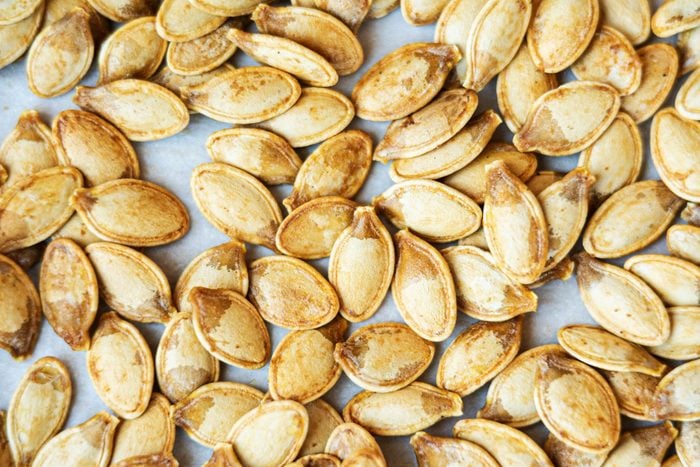I Ate Pumpkin Seeds Every Day for a Week—Here’s What Happened
Updated: Dec. 23, 2023

Our writer explains why a week-long experiment adding crunchy pumpkin seeds to her meals will remain a habit.
Spooky season is upon us—and with it comes all-things-pumpkin, whether you’re a pumpkin spice lover or can’t wait to carve up some gourdy decor. Yet according to the US Department of Energy, four-fifths of the 1.5 billion pumpkins grown in the US each year are used for decoration only. Of those, almost all are thrown in the trash: An enormous amount of wasted (and incredibly nutritious) food.
So, in honor of the humble pumpkin, I incorporated perhaps its most overlooked part into my diet for the week—the pumpkin seed. This tiny nutritional powerhouse falls under the “superfood” umbrella in nutritional circles, a term that describes foods particularly dense in vitamins, minerals and other beneficial compounds.
The American Heart Association recommends eating just a quarter cup of pumpkin seeds daily—could such a small dietary addition make much of a difference? As it turns out, getting my serving of pumpkin seeds is a habit I’ll be continuing beyond this experimental week.
5 Powerfully Healthy Pumpkin Recipes
What’s the nutritional value of pumpkin seeds?
To better understand how to incorporate pumpkin seeds into my diet, I turned to Stephanie Roit, RD, a registered dietician at NewYork-Presbyterian/Weill Cornell Medical Center. This nutrition expert explains that you can’t really go wrong adding some nuts and seeds to your diet, as they all contain heart-healthy fats and fiber—which most of us aren’t getting enough of.
Compared to other nuts and seeds, though, pumpkin seeds are particularly high in magnesium, iron, zinc and vitamin K, she says. “One-quarter cup of pumpkin seeds provides about one-third of the recommended intake for magnesium, a nutrient that surveys have shown many people in the United States are not getting adequate intakes of.” They also provide a good amount of plant-based protein and contain copper and manganese.
Eating This Nut Will Help Your Gut and Reduce Inflammation, New Study Says
The best way to eat pumpkin seeds
With a relatively small serving size, you could simply eat a 30-gram handful of pumpkin seeds as a snack—and it doesn’t matter if they’re store-bought or scooped right out of a pumpkin. Nutritional value doesn’t differ significantly between raw or roasted pumpkin seeds, Roit explains. If they’re store-bought, just look out for added sodium or flavorings—plain is nutritionally best.
There is some value in adding pumpkin seeds to meals instead, though. “Someone with a sensitive digestive tract may have discomfort eating too many pumpkin seeds in one sitting due to their high fiber and healthy fat content,” Roit says.
In addition: “Pumpkin seeds are a good source of plant-based iron, which is not absorbed as well in the body as the form of iron found in animal foods,” Roit says. Foods that contain vitamin C help increase the body’s absorption of this plant-based iron.
7 Foods You Should Never Eat By Themselves
Eating pumpkin seeds every day for a week
My week began with pumpkin seeds on top of avocado toast with a squirt of lemon to help my body absorb the iron. (On day two, I topped with some pickled onions, too—this was a winner.) Then I tried pumpkin seeds mixed into cottage cheese with chunks of kiwi, and if you’re a fan of meals with a big blend of different textures, this one’s for you!
On the mornings I planned to work out, I was conscious of the extra fiber upsetting my stomach. Roit had a great solution: Blending the seeds into a smoothie. “This makes them more easily digestible, and they will retain their vitamin and mineral content.”
As for lunch and dinner, it turns out that you can add pumpkin seeds to almost anything, thanks to their rather neutral flavor. I tossed them in all sorts of salads and grain bowls, snuck them into sandwiches and even chucked them into bolognese sauce—in each meal, they were a subtle addition with a satisfying crunch. While in the spirit, I also baked them into banana bread (yum) and, of course, snacked on them au-natural: roasting the seeds in the oven with some olive oil, salt and paprika.
16 Bedtime Snacks That Will Help You Sleep Better
You may have more energy eating pumpkin seeds every day
So, did this superfood deliver on its nutritional promise? According to a 2022 review of research published in Plants, if I keep the habit up, I can earn a lower risk of heart problems, diabetes, mental health problems, inflammatory issues and cancer.
Even so, in just one week I recognized noticeable improvements to my energy and hunger levels throughout the day—likely thanks to the extra dose of healthy fats, plant protein and fiber, particularly first thing in the morning. I also felt good knowing I was incorporating more iron into my diet—a 2021 study published in The Journal of Nutrition says that dietary intake of iron has been dropping for years among Americans.
Interestingly, I also noticed that I recovered from physical activity better and I slept great. The nutrients and healthy fats in pumpkin seeds have anti-inflammatory properties, which may help with muscle recovery. Yet experts believe that magnesium is essential for quality, restorative sleep, which, in turn, is vital for physical recovery—and most of us don’t get enough magnesium or sleep.
The verdict? A serving of pumpkin seeds a day helped me top up some crucial nutrients many of us lack, support my active lifestyle, and get a better night’s rest. So get carving!
For wellness updates delivered daily, subscribe to The Healthy @Reader’s Digest newsletter and follow The Healthy on Facebook and Instagram. Keep reading:





















